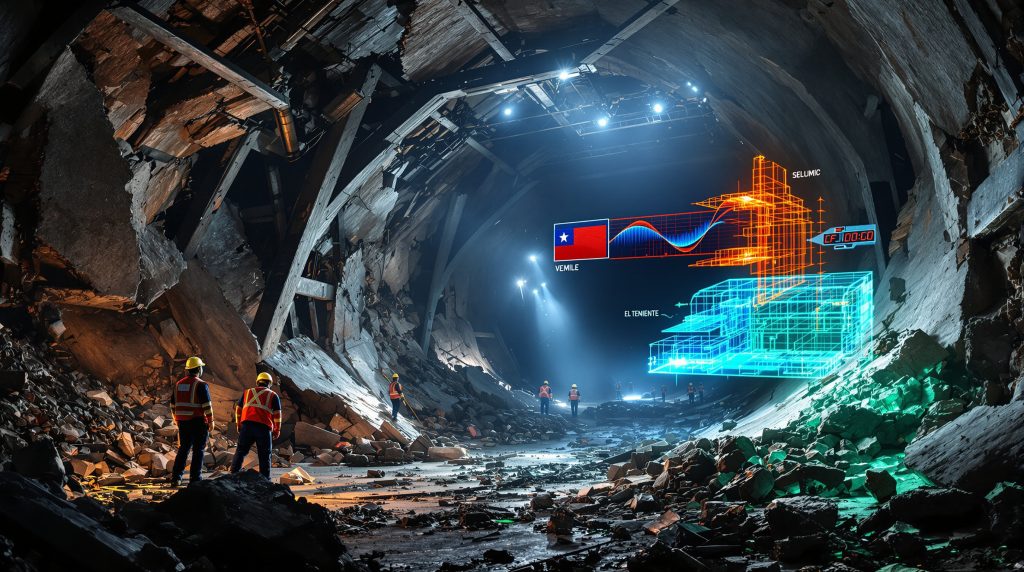Understanding Chile's El Teniente Mine Collapse Investigation
The recent fatal collapse at Chile's El Teniente copper mine has triggered what officials describe as a complex and lengthy investigation process. This detailed examination follows one of the deadliest mining accidents in Chile's recent history, with significant implications for the world's top copper producer. The investigation's scope and duration highlight the serious nature of mine safety in a country where copper extraction forms a cornerstone of the economy and provides valuable copper industry insights.
What Happened at El Teniente Mine in Chile?
The Fatal Incident Overview
On July 31, 2025, tragedy struck at Codelco's El Teniente copper mine when a tunnel collapsed, claiming the lives of six workers and injuring nine others. This devastating incident occurred in the Andesita sector of the mine, marking it as the deadliest mining accident in Chile in recent years. El Teniente holds particular significance as the world's largest underground copper mine, contributing approximately 2% of global copper supply.
The incident has sent ripples through Chile's mining industry evolution, drawing attention to safety protocols and infrastructure integrity in aging mining operations. The scale of the disaster has prompted not only local concern but international attention given El Teniente's prominence in global copper production.
Timeline of the Emergency Response
Following the collapse, mine operations were immediately suspended as emergency teams mobilized to assess the damage and conduct rescue operations. Early reports indicated that rescue efforts faced significant challenges due to unstable underground conditions, complicating both the initial response and subsequent investigation efforts.
State-owned Codelco, Chile's National Copper Corporation and the mine's operator, quickly assembled an international panel of experts to conduct a comprehensive audit of the site. Simultaneously, Sernageomin, Chile's National Geology and Mining Service, launched its official investigation to determine the causes and circumstances surrounding the collapse.
Why Will the Investigation Take Months to Complete?
Complexity Factors Extending the Investigation Timeline
Andres Leon, Sernageomin's director, has explicitly cited "the complexity of the accident" as the primary reason for the extended investigation timeline. Speaking to Reuters, Leon stated that "due to the complexity of the accident it's hard to determine an exact date," but indicated that "in the next few months we should have something to report."
While the official statement remains limited, mining safety experts point to several factors that typically complicate such investigations:
- The need to thoroughly examine extensive tunnel networks for structural integrity
- Challenges in safely accessing collapsed areas for evidence collection
- Complex analysis of geological and seismic data before, during, and after the incident
- Coordination between multiple investigating bodies with different objectives
- Detailed forensic examination of structural failures and material behaviors
Investigative Scope and Methodology
The investigation process for major mining accidents involves multiple parallel tracks of inquiry. In cases of significant structural failures like the El Teniente collapse, investigators typically conduct:
- Comprehensive structural assessments of affected tunnels and surrounding areas
- Analysis of maintenance records and previous structural inspections
- Evaluation of safety protocols and their implementation prior to the incident
- Review of worker training and emergency preparedness procedures
- Interviews with survivors, witnesses, and mine personnel
Mining safety investigations must balance the urgency of preventing future incidents with the methodical collection and analysis of evidence. This tension often contributes to extended investigation timelines, especially in cases involving multiple fatalities and complex structural failures.
Who Is Leading the Investigation Process?
Key Investigating Authorities and Their Roles
Sernageomin stands at the forefront of the investigation as Chile's primary mining regulatory body. Director Andres Leon is personally overseeing this high-profile case, underscoring its significance to the national mining industry and worker safety standards.
The investigation likely involves additional authorities, potentially including:
- Chile's Public Ministry, which may conduct a parallel criminal investigation if negligence is suspected
- Occupational safety specialists evaluating compliance with workplace safety regulations
- Independent technical experts providing specialized knowledge in underground mining structures
- Labor representatives ensuring workers' interests are considered throughout the process
This multi-faceted approach aims to produce a comprehensive understanding of what went wrong and how similar incidents can be prevented in the future.
Investigation Objectives and Focus Areas
While specific details about the investigation's scope remain limited in official communications, standard protocols for such incidents suggest several primary objectives:
- Determining the precise cause of the tunnel collapse
- Assessing compliance with established safety regulations and industry standards
- Identifying any warning signs or precursors that may have been overlooked
- Evaluating the effectiveness of emergency response procedures
- Developing recommendations to prevent similar incidents in other mining operations
The investigation's findings will likely have significant implications not only for El Teniente's operations but for mining safety standards throughout Chile and potentially globally.
What Are the Broader Implications for Chile's Mining Industry?
Safety Standards and Regulatory Impact
The El Teniente collapse comes at a critical time for Chile's mining industry, which continues to balance production demands with worker safety concerns. As the world's largest copper producer, Chile's mining sector operates under intense scrutiny from both national regulators and international observers.
This incident may prompt:
- Renewed examination of safety protocols in underground mining operations
- Enhanced regulatory oversight of aging mine infrastructure
- Increased investment in structural monitoring technologies
- Strengthened enforcement of existing safety standards
- Development of more robust emergency response capabilities
Mining safety experts note that major incidents often serve as catalysts for regulatory evolution, particularly when they expose systemic vulnerabilities in existing practices.
Economic and Industry Consequences
Beyond the immediate human tragedy, the El Teniente incident carries potential long-term implications for Chile's copper industry and global supply chains. As a major contributor to global copper production, extended disruptions at El Teniente could affect international markets for the essential metal.
The incident highlights several challenging dynamics:
- The balance between production targets and safety investments
- The technical challenges of maintaining aging mine infrastructure
- The economic impact of safety-related production disruptions
- The reputational considerations for state-owned operators like Codelco
- The potential influence on future mining development projects in Chile
Industry analysts will be closely watching how Codelco and Chilean authorities respond to this incident, as their actions may set precedents for handling similar challenges in other mining operations.
How Has Codelco Responded to the Tragedy?
Company Actions and Commitments
While detailed information about Codelco's specific responses remains limited in available reports, standard industry protocols for such incidents typically include:
- Immediate suspension of operations in affected areas
- Provision of support services for victims' families and injured workers
- Full cooperation with regulatory investigations
- Internal technical reviews of similar mine areas
- Public commitments to implementing necessary safety improvements
As Chile's state-owned copper mining company, Codelco faces particular scrutiny in its response to the incident. The company's handling of this tragedy will likely influence public and industry perceptions of its commitment to worker safety and operational responsibility.
Operational and Safety Measures
In the aftermath of serious mining incidents, operators typically implement both immediate and long-term safety measures. For Codelco at El Teniente, these might include:
- Comprehensive structural assessments throughout the mine complex
- Enhanced monitoring systems for early detection of potential failures
- Review and potential revision of evacuation procedures
- Additional safety training for underground personnel
- Reevaluation of communication systems for emergency situations
The effectiveness of these measures will be a critical factor in restoring confidence in the operation's safety and Codelco's management of one of the world's most significant copper mines.
What Role Do Seismic Events Play in Mining Accidents?
Understanding Mining-Induced Seismicity
Underground mining operations, especially those at significant depths like El Teniente, must contend with complex geological forces. Mining activities can both respond to and sometimes trigger seismic events through:
- Redistribution of stress in rock formations due to excavation
- Pressure changes resulting from the removal of ore and surrounding material
- Blasting operations that can affect existing fracture networks
- Alteration of groundwater dynamics affecting rock stability
- Reactivation of pre-existing geological fault lines
Understanding these relationships is crucial for developing effective safety protocols in seismically active mining regions like those found in Chile's copper belt.
Seismic Risk Management in Underground Mining
Modern underground mining operations employ various strategies to manage seismic risks, including:
- Advanced monitoring systems that track microseismic activity
- Ground support designs specifically engineered for dynamic loading conditions
- Sequencing of mining activities to minimize stress concentrations
- Exclusion zones during high-risk activities or following detected seismic events
- Emergency response protocols tailored to seismic scenarios
The investigation at El Teniente will likely examine how effectively these or similar measures were implemented prior to the fatal collapse, potentially informing industry-wide improvements in seismic risk management.
What Are the Challenges in Investigating Underground Mine Collapses?
Technical and Logistical Difficulties
Investigating underground mine collapses presents unique challenges that contribute to extended timelines. These investigations must navigate:
- Hazardous conditions that may limit direct access to collapse sites
- The need to stabilize areas before detailed examination can proceed
- Complex three-dimensional environments that are difficult to document
- The potential for secondary collapses during investigation activities
- Challenges in preserving evidence while conducting recovery operations
These factors help explain Sernageomin Director Leon's comments about the investigation's complexity and extended timeline.
Evidence Collection and Analysis Methodologies
Modern mine collapse investigations employ sophisticated technologies and methodologies to overcome access limitations, including:
- Remote sensing equipment to examine inaccessible areas
- LiDAR scanning for precise three-dimensional documentation
- Geotechnical instrumentation to monitor ongoing ground movements
- Laboratory analysis of rock samples and support materials
- Computer modeling of collapse scenarios based on collected data
The thoroughness of these processes contributes to longer investigation timelines but ultimately produces more comprehensive and useful findings for preventing future incidents. Modern 3D geological modelling has become increasingly important for understanding the complex structural failures in such situations.
How Has the Public and Mining Community Reacted?
Labor Union Responses and Demands
Mining accidents of this magnitude typically generate significant responses from labor organizations representing mine workers. While specific reactions to the El Teniente incident remain limited in available reports, mining unions often advocate for:
- Independent investigations separate from company-led inquiries
- Transparency in sharing investigation findings
- Improved safety measures and worker protections
- Accountability for any identified negligence
- Appropriate compensation for affected workers and families
The relationship between mining companies, regulators, and labor representatives often evolves following serious accidents, sometimes resulting in improved collaboration on safety initiatives.
Public and Media Attention
The El Teniente collapse has drawn significant media attention as one of Chile's deadliest mining incidents in recent years. This attention serves several important functions:
- Maintaining focus on worker safety in a critical national industry
- Providing public accountability for investigation processes
- Highlighting the human impact of mining safety failures
- Facilitating discussion about the balance between production and safety
- Creating pressure for meaningful safety improvements
How this attention influences the investigation process and resulting recommendations will be an important aspect of the incident's long-term impact.
What Safety Improvements Could Result from the Investigation?
Potential Regulatory and Industry Changes
Major mining incidents often catalyze significant changes in regulatory frameworks and industry practices. Potential outcomes from the El Teniente investigation might include:
- Updated regulatory requirements for tunnel support systems
- Enhanced monitoring protocols for aging mine infrastructure
- More stringent inspection schedules for high-risk mining areas
- Improved emergency response planning requirements
- Strengthened enforcement mechanisms for safety violations
The investigation's findings will likely inform not only specific changes at El Teniente but broader safety initiatives throughout Chile's mining sector.
Technological and Methodological Advancements
Beyond regulatory changes, mining incidents often accelerate the adoption of new safety technologies and methodologies, such as:
- Advanced real-time monitoring systems for tunnel stability
- Improved modeling tools for predicting ground behavior
- Enhanced communication systems for underground operations
- Robotics for inspection of high-risk areas
- Data analytics for identifying potential safety concerns before incidents occur
How the El Teniente investigation influences these technological adoptions may have lasting impacts on mining safety practices globally. The trend toward data-driven mining could be accelerated in response to safety concerns highlighted by this tragedy.
Learning from Tragedy to Prevent Future Accidents
Key Takeaways from the El Teniente Investigation
While the investigation remains ongoing, mining safety experts emphasize several critical lessons that typically emerge from such incidents:
- The importance of proactive risk assessment in aging mining infrastructure
- The need for continuous monitoring and inspection of critical support systems
- The value of well-designed and regularly practiced emergency response procedures
- The significance of worker input in identifying potential safety concerns
- The necessity of balancing production goals with safety requirements
These principles will likely inform the specific recommendations resulting from the El Teniente investigation.
Moving Forward: The Path to Safer Mining Operations
The mining industry's response to tragic incidents like the El Teniente collapse typically follows several phases:
- Immediate response and incident stabilization
- Thorough investigation to determine causes and contributing factors
- Development of specific recommendations to address identified issues
- Implementation of improved safety measures and protocols
- Long-term monitoring to assess effectiveness and ensure compliance
This process, while often lengthy and complex, represents the industry's best path toward preventing similar tragedies in the future. Additionally, mine reclamation advancements may need to incorporate new safety considerations based on findings from this investigation.
The investigation into the fatal mine collapse in Chile stands as a critical moment for Chile's mining industry. Its outcomes will influence not only operational practices at this particular mine but potentially safety standards throughout the country's vital copper sector. As Director Leon indicated, the investigation's complexity demands time and thoroughness to produce meaningful findings that can help prevent future losses.
Looking for Early Insights into Major Mining Discoveries?
Discovery Alert's proprietary Discovery IQ model instantly identifies significant ASX mineral discoveries, turning complex data into actionable investment insights. Explore our dedicated discoveries page to understand how major mineral discoveries have historically delivered exceptional returns, and begin your 30-day free trial today.




